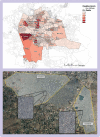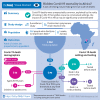Covid-19 deaths in Africa: prospective systematic postmortem surveillance study
- PMID: 33597166
- PMCID: PMC7887952
- DOI: 10.1136/bmj.n334
Covid-19 deaths in Africa: prospective systematic postmortem surveillance study
Abstract
Objective: To directly measure the fatal impact of coronavirus disease 2019 (covid-19) in an urban African population.
Design: Prospective systematic postmortem surveillance study.
Setting: Zambia's largest tertiary care referral hospital.
Participants: Deceased people of all ages at the University Teaching Hospital morgue in Lusaka, Zambia, enrolled within 48 hours of death.
Main outcome measure: Postmortem nasopharyngeal swabs were tested via reverse transcriptase quantitative polymerase chain reaction (PCR) against severe acute respiratory syndrome coronavirus 2 (SARS-CoV-2). Deaths were stratified by covis-19 status, location, age, sex, and underlying risk factors.
Results: 372 participants were enrolled between June and September 2020; PCR results were available for 364 (97.8%). SARS-CoV-2 was detected in 58/364 (15.9%) according to the recommended cycle threshold value of <40 and in 70/364 (19.2%) when expanded to any level of PCR detection. The median age at death among people with a positive test for SARS-CoV-2 was 48 (interquartile range 36-72) years, and 69% (n=48) were male. Most deaths in people with covid-19 (51/70; 73%) occurred in the community; none had been tested for SARS-CoV-2 before death. Among the 19/70 people who died in hospital, six were tested before death. Among the 52/70 people with data on symptoms, 44/52 had typical symptoms of covid-19 (cough, fever, shortness of breath), of whom only five were tested before death. Covid-19 was identified in seven children, only one of whom had been tested before death. The proportion of deaths with covid-19 increased with age, but 76% (n=53) of people who died were aged under 60 years. The five most common comorbidities among people who died with covid-19 were tuberculosis (22; 31%), hypertension (19; 27%), HIV/AIDS (16; 23%), alcohol misuse (12; 17%), and diabetes (9; 13%).
Conclusions: Contrary to expectations, deaths with covid-19 were common in Lusaka. Most occurred in the community, where testing capacity is lacking. However, few people who died at facilities were tested, despite presenting with typical symptoms of covid-19. Therefore, cases of covid-19 were under-reported because testing was rarely done not because covid-19 was rare. If these data are generalizable, the impact of covid-19 in Africa has been vastly underestimated.
Published by the BMJ Publishing Group Limited. For permission to use (where not already granted under a licence) please go to http://group.bmj.com/group/rights-licensing/permissions.
Conflict of interest statement
Competing interests: All authors have completed the ICMJE uniform disclosure form at www.icmje.org/coi_disclosure.pdf and declare: support from the Bill & Melinda Gates Foundation; no financial relationships with any organizations that might have an interest in the submitted work in the previous three years; no other relationships or activities that could appear to have influenced the submitted work.
Figures






Comment in
-
Covid-19 in Africa.BMJ. 2021 Feb 19;372:n457. doi: 10.1136/bmj.n457. BMJ. 2021. PMID: 33608322 No abstract available.
References
-
- Troeger C. Just how do deaths due to COVID-19 stack up? 2020 https://www.thinkglobalhealth.org/article/just-how-do-deaths-due-covid-1....
Publication types
MeSH terms
LinkOut - more resources
Full Text Sources
Other Literature Sources
Medical
Miscellaneous
